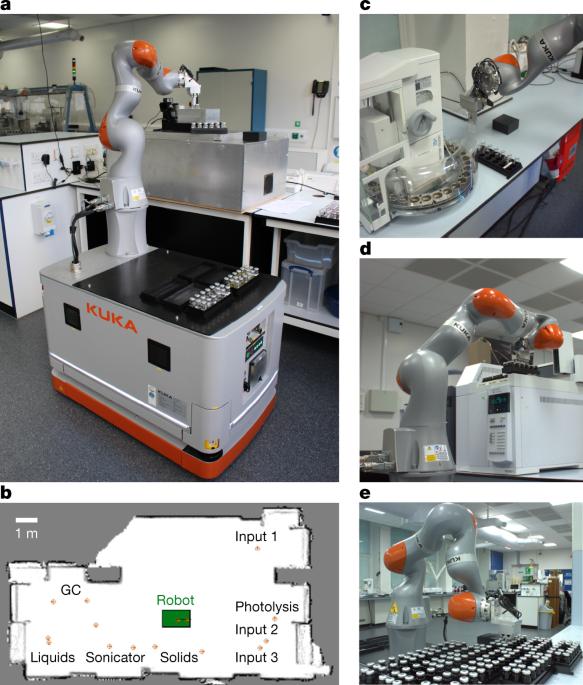移动式机器人化学家
IF 48.5
1区 综合性期刊
Q1 MULTIDISCIPLINARY SCIENCES
引用次数: 521
摘要
电池、生物材料和异质催化剂等技术的功能是由分子和中尺度成分的混合物决定的。然而,原子模拟无法完全捕捉到这种多长度尺度的复杂性,从第一原理出发设计此类材料的情况仍然十分罕见1-5。同样,实验的复杂性也会随着变量数量的增加而呈指数级增长,从而将大多数搜索限制在材料空间的狭窄区域。机器人可以协助实验搜索6-14,但由于样品类型、操作、仪器和测量要求的多样性,在材料研究中广泛采用机器人具有挑战性。在这里,我们使用移动机器人寻找改进的光催化剂,用于从水中制氢15。在分批贝叶斯搜索算法的驱动下,机器人自主运行了八天,在十变量实验空间内进行了 688 次实验16-18。这种自主搜索能识别出比初始配方活性高出六倍的光催化剂混合物,选择有益成分,剔除有害成分。我们的策略使用灵巧的19,20 自由漫游机器人21-24 ,实现了研究人员而非仪器的自动化。这种模块化方法可用于传统实验室,解决光催化以外的一系列研究问题。移动机器人可在湿化学实验室中自主操作分析仪器,以比人类快得多的速度完成光催化剂优化任务。本文章由计算机程序翻译,如有差异,请以英文原文为准。

A mobile robotic chemist
Technologies such as batteries, biomaterials and heterogeneous catalysts have functions that are defined by mixtures of molecular and mesoscale components. As yet, this multi-length-scale complexity cannot be fully captured by atomistic simulations, and the design of such materials from first principles is still rare1–5. Likewise, experimental complexity scales exponentially with the number of variables, restricting most searches to narrow areas of materials space. Robots can assist in experimental searches6–14 but their widespread adoption in materials research is challenging because of the diversity of sample types, operations, instruments and measurements required. Here we use a mobile robot to search for improved photocatalysts for hydrogen production from water15. The robot operated autonomously over eight days, performing 688 experiments within a ten-variable experimental space, driven by a batched Bayesian search algorithm16–18. This autonomous search identified photocatalyst mixtures that were six times more active than the initial formulations, selecting beneficial components and deselecting negative ones. Our strategy uses a dexterous19,20 free-roaming robot21–24, automating the researcher rather than the instruments. This modular approach could be deployed in conventional laboratories for a range of research problems beyond photocatalysis. A mobile robot autonomously operates analytical instruments in a wet chemistry laboratory, performing a photocatalyst optimization task much faster than a human would be able to.
求助全文
通过发布文献求助,成功后即可免费获取论文全文。
去求助
来源期刊

Nature
综合性期刊-综合性期刊
CiteScore
90.00
自引率
1.20%
发文量
3652
审稿时长
3 months
期刊介绍:
Nature is a prestigious international journal that publishes peer-reviewed research in various scientific and technological fields. The selection of articles is based on criteria such as originality, importance, interdisciplinary relevance, timeliness, accessibility, elegance, and surprising conclusions. In addition to showcasing significant scientific advances, Nature delivers rapid, authoritative, insightful news, and interpretation of current and upcoming trends impacting science, scientists, and the broader public. The journal serves a dual purpose: firstly, to promptly share noteworthy scientific advances and foster discussions among scientists, and secondly, to ensure the swift dissemination of scientific results globally, emphasizing their significance for knowledge, culture, and daily life.
 求助内容:
求助内容: 应助结果提醒方式:
应助结果提醒方式:


